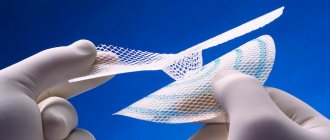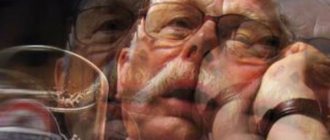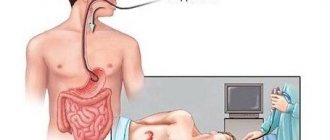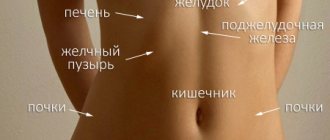Hernia of the white line of the abdomen is a disease in which protrusion of part of the organs occurs through the openings between the muscles along the average line of the peritoneum.
Normal thickness of the linea alba
can range from 1 to 3 centimeters, but if there is a pathology, it begins to increase to 10 centimeters.
Among hernias of the anterior abdominal wall, a similar disease is rare and accounts for 2-9%. Increasingly, a hernia is diagnosed in men aged 20 to 35 years, but it can also appear in women, children and older people.
A hernia on the linea alba does not appear suddenly; it develops slowly. There are several stages of the disease: preperitoneal lipoma, initial stage and final formation. First, preperitoneal tissue emerges through the gap and a lipoma appears. At the initial stage, a hernial sac is born, which will affect a section of the small intestine or part of the omentum. The final formation of the pathology is accompanied by the formation of a hernial orifice and a sac. Increasingly, hernias appear one at a time; they are not always multiple, located one above the other.
Causes
Congenital or acquired weakness of connective tissues often becomes the basis for the occurrence of an abdominal hernia on the white line. At the same time, its thinning, increase, the appearance of holes and diastasis (muscle divergence) are noted.
Causes of weakened connective tissue in adults and children include:
- Genetic predisposition.
- Obesity.
- Abdominal injuries.
- Postoperative scars.
Enormous intra-abdominal pressure also poses a danger. Its appearance is provoked by the following factors:
- Physical overexertion.
- Constipation.
- Pregnancy.
- Diseases accompanied by a prolonged cough (whooping cough, chronic bronchitis, etc.).
- Difficult birth.
- In children, prolonged crying also screams.
What is the threat?
The appearance of a “gap” in the anterior wall of the peritoneum can lead to strangulation of organs that exit through the hernial orifice. A sign of a similar complication is the irreducibility of the hernia, in which the sac cannot return to the body either independently or with the help of a hand. In this case, the patient is indicated for urgent, timely intervention.
Dangerous complications of a hernia also include:
- Inflammation and damage to the internal organ located in the hernial orifice.
- Intestinal obstruction.
- Protrusion of the hernia (occurs at the final stage of development of the pathology).
- Development of peritonitis.
- Suppuration.
In what cases does an abdominal hernia appear?
The abdominal wall consists of connective, muscle tissue. The main job of the abdominal wall is to support the organs of the body in the abdominal cavity.
The exit of the digestive organs occurs due to weakened muscles that are unable to maintain a balance between intra-abdominal pressure and the resistance of the abdominal wall.
Places where only connective tissue remains are called weak. They gradually stretch, forming a hernial orifice. Part of the parietal or visceral peritoneum prolapses through the hilum under the skin of the abdomen or groin. This area is called the hernial sac.
There are congenital and acquired hernias. The reasons for their occurrence are heredity or mechanical influence (trauma).
The disease is also provoked by:
- excess weight
- excessive physical activity
- lifting weights
- pregnancy, pushing during childbirth
- inflammation of internal organs, cirrhosis of the liver
- cough in chronic lung diseases, tuberculosis
- disorders in the urinary system, gastrointestinal tract
- starvation, exhaustion of the body
- age-related changes
Often, a hernia may appear after surgery due to improper suturing of the wound or infection.
Protrusion of the digestive organs can begin either immediately after surgery or several years later. Favorable conditions for the development of a postoperative hernia are genetic defects and concomitant chronic diseases (diabetes mellitus, obesity).
Failure to follow the surgeon’s recommendations during the recovery period can lead to the release of the insides. For example, physical activity at the early stage of rehabilitation.
Diagnostics
An abdominal hernia, localized on the white line , can be located above, near and below the navel. The latter are very rare. The doctor makes a conclusion based on:
- Inspection data. When palpating the linea alba , a lump is found, and the patient may feel pain.
- X-ray examination of the contents of the hernial sac with preliminary administration of a contrast agent (barium).
- Ultrasound examination (ultrasound).
- Computed tomography.
Operation
Hernia of the white line
cannot be cured by conservative methods; only timely intervention is used. Access to the hernia is performed using three methods, each of them has negative and positive aspects; the choice of treatment depends on the age and condition of the patient.
During the postoperative period, patients are prescribed medications to relieve pain, walks in clean air and light physical activity (special training complex, gymnastics) are recommended. It is also necessary to give up bad habits (smoking and drinking alcohol). In addition, after surgery, patients are not allowed to drive vehicles.
Wearing a corset can help quickly restore muscle tone, which will eliminate relapse. If the patient worked in difficult conditions before timely intervention, then he needs to change his job and switch to easier work.
Open access
Performed using a cut with a length equal to the vertical size of the bulge.
The positive side of the method:
- Preservation of the internal organ located within the hernia.
- Quality of allograft fixation.
- Low repetition rate.
- Possibility of timely treatment under local anesthesia.
The main disadvantages are severe pain during the operation and the appearance of a long scar. The graft, made of hypoallergenic materials of excellent quality, takes on the entire load, protecting the tissue from new stretches. The need for its installation is mainly determined during the operation, when it is clearly visible in what condition the patient’s native tissues are.
Laparoscopic access
Performed using medical video equipment and surgical instruments through 3 small punctures on the abdomen.
The advantages of laparoscopy are small scars on the abdomen, and less severe pain during rehabilitation.
The disadvantages include:
- The need for general anesthesia.
- Filling the peritoneum with carbon dioxide, which is contraindicated in patients with lung and heart diseases.
- Reliability of mesh fixation is too low.
- High repetition rate.
Preperitoneal access
Like laparoscopic, it is carried out through small punctures using surgical instruments and video equipment, but without penetrating the peritoneum and without filling it with gas. The positive side is the possible (but undesirable) use of local anesthesia.
The negative side of this type of operation is as follows:
- Lack of fastening of the mesh, due to which it can begin to twist and move.
- Duration of surgical intervention.
- High technical difficulty.
- Danger of damage to organs that are part of the hernia.
Excerpt characterizing the linea alba
Meanwhile, Kutuzov approached the village and sat down in the shade of the nearest house on a bench, which one Cossack ran and quickly covered with a rug. A huge brilliant retinue surrounded the commander-in-chief. The icon moved on, followed by the crowd. Pierre stopped about thirty paces from Kutuzov, talking to Boris. Pierre explained his intention to participate in the battle and inspect the position. “Here’s how to do it,” said Boris. – Je vous ferai les honneurs du camp. [I will treat you to the camp.] You will best see everything from where Count Bennigsen will be. I'm with him. I'll report to him. And if you want to go around the position, then come with us: we are now going to the left flank. And then we’ll come back, and you’re welcome to spend the night with me, and we’ll form a party. You know Dmitry Sergeich, right? He’s standing here,” he pointed to the third house in Gorki. “But I would like to see the right flank; they say he is very strong,” said Pierre. – I would like to drive from the Moscow River and the entire position. - Well, you can do that later, but the main one is the left flank... - Yes, yes. Can you tell me where Prince Bolkonsky’s regiment is? – asked Pierre. - Andrey Nikolaevich? We'll pass by, I'll take you to him. - What about the left flank? – asked Pierre. “To tell you the truth, entre nous, [between us], God knows what position our left flank is in,” said Boris, trustingly lowering his voice, “Count Bennigsen did not expect it at all.” He intended to strengthen that mound over there, not at all like that... but,” Boris shrugged. – His Serene Highness didn’t want to, or they told him to. After all... - And Boris did not finish, because at that time Kaysarov, Kutuzov’s adjutant, approached Pierre. - A! Paisiy Sergeich,” said Boris, turning to Kaisarov with a free smile, “But I’m trying to explain the position to the count.” It’s amazing how His Serene Highness could so correctly guess the intentions of the French! – Are you talking about the left flank? - said Kaisarov. - Yes yes exactly. Our left flank is now very, very strong. Despite the fact that Kutuzov kicked out all unnecessary people from the headquarters, Boris, after the changes made by Kutuzov, managed to stay at the main apartment. Boris joined Count Bennigsen. Count Bennigsen, like all the people with whom Boris was, considered the young Prince Drubetskoy an unappreciated person. There were two sharp, definite parties in command of the army: the party of Kutuzov and the party of Bennigsen, the chief of staff. Boris was present at this last game, and no one knew better than he, while paying servile respect to Kutuzov, to make one feel that the old man was bad and that the whole business was being conducted by Bennigsen. Now the decisive moment of the battle had come, which was either to destroy Kutuzov and transfer power to Bennigsen, or, even if Kutuzov had won the battle, to make it felt that everything had been done by Bennigsen. In any case, big rewards were to be given out tomorrow and new people were to be brought forward. And as a result of this, Boris was in irritated animation all that day.
Diet after surgery
The main goal of dietary nutrition after removal of a hernia is to reduce intestinal pressure on the surgical site. This can be achieved through proper split meals and the exclusion of foods that cause increased gas, speed up the process of digesting food, and in addition help constipation.
To restore the successful functioning of the intestines within several days after surgical intervention, patients are asked to take liquid and semi-liquid foods: yogurt, kefir, light pureed soups, low-fat broths, jelly, cottage cheese, etc. Solid foods can also be added slowly. To eliminate constipation and maintain water balance, you need to drink at least 1.5 liters of clean water throughout the day.
Prohibited products after removing a hernia include:
- Legumes.
- Fatty meat and fish.
- Marinades and smoked meats.
- Vegetables (cabbage, radishes, radishes, bell peppers, tomatoes, spinach, sorrel, garlic and onions).
- Fruits (apples, pears, bananas, grapes and peaches).
- Black tea, coffee and carbonated drinks.
- Mushrooms.
- Rye bread and pastries made from yeast dough.
- Porridges made from corn, pearl barley and millet.
- Whole milk, ice cream, cream.
- Hard-boiled eggs.
- Dried fruits (dried apricots, prunes).
- Seeds and nuts.
- Hot sauces and seasonings.
- Pickled and salted vegetables.
Recovery time for the body after surgery
The rehabilitation process depends on the stage of the disease at which the operation was performed. And also from complications and concomitant chronic diseases. After the operation, the patient can move without assistance, and the next day he is discharged.
Within a week, the patient comes to the hospital for dressing. After about 7-10 days, the sutures are removed. For three months, a person wears a bandage to restore muscle tone.
An elastic belt reduces the risk of re-development of a hernia and protects the skin from irritation. You will have to give up intense training.
During pregnancy
Hernia of the white line of the abdomen is a pathology that is often diagnosed in pregnant women. The basis for its occurrence is mainly considered to be increased intra-abdominal pressure. This occurs due to the gradual growth of the fetus and the enlargement of the uterus.
During pregnancy, the question of timely intervention is rarely raised. Exceptions include situations where complications arise, for example, organ strangulation.
If there are no difficulties, then women expecting a child are offered:
- Wear a special corset or bandage that can help eliminate the possibility of squeezing the contents of the hernial sac .
- Do not lift heavy objects.
- Remove any factors that may contribute to increased intra-abdominal pressure.
Why does a hernia form?
The expansion of the white line in men is often determined by a discrepancy between the development of muscle tissue and its aponeurosis. Abdominal hernias in women occur due to weakening of the abdominal wall due to frequent repeated pregnancies. The causes of the pathology are conventionally divided by nature: into factors that increase intra-abdominal pressure, contributing to the weakening of the tendons of the abdominal muscles.
The first include:
- heavy physical work, weight lifting for weightlifters;
- the passion of teenagers, young men and girls for bodybuilding, the desire to “pump up the abs”;
- enlarged abdomen due to abdominal fat in obesity, ascites due to fluid accumulation caused by venous blood retention (portal hypertension in liver cirrhosis, circulatory failure);
- diseases leading to prolonged constipation;
- suffered complicated pregnancies and childbirths;
- diseases that cause prolonged severe coughing and vomiting;
- pathology of the genitourinary system, contributing to urinary retention (prostatitis, malignant and benign tumors of the prostate, bladder, urolithiasis);
- babies cry for various reasons.
Weakness of the aponeurosis and tendons can be caused by sudden weight loss.
Postoperative scars in the area of the white line lead to weakness of the tendons. Such hernias are called ventral. Many abdominal surgeries require an incision along the linea alba (laparotomy). This improves access to the required area, provides more opportunity to examine the entire abdominal cavity, ligate vessels and eliminate bleeding during the recovery period. However, there is an increased risk of postoperative hernia.
Traumatic injuries to the abdomen are most common among athletes; closed and open types occur from bruises, falls from a height, during road accidents, gunshot and knife wounds. There may be a hereditary predisposition caused by impaired collagen synthesis in connective tissue.
Most often, the reasons are mixed. But finding out the main factors is important for deciding on the treatment of a particular person and preventing relapse. You can learn more about the causes of linea alba hernia in newborns from this article.
In children
In children, a hernia is often accompanied by strangulation of the hernial sac, due to this they feel constant pain. In severe cases, peritonitis is possible with characteristic manifestations:
- Vomit.
- Heat.
- General weakness.
- Bloating.
- Signs of peritoneal irritation.
A frequent basis for the occurrence of a hernia in children in the area of the white line of the abdomen is considered to be weakness of the connective tissue framework, which is congenital in nature. Since it is almost impossible to fix it, self-healing rarely occurs.
If a child is diagnosed with an abdominal hernia, surgical removal is required. This will prevent the development of similar difficulties, such as strangulation of the hernial sac, an increase in the size of the defect, and the development of adhesive disease. The operation in children is performed under general anesthesia, regardless of age. Through such a short incision, the contents of the hernial sac are reduced into the peritoneum, after which the aponeurosis defect is sutured. The doctor establishes cosmetic connections, which then dissolve.
To prevent the formation of an abdominal hernia in the area of the white line
, you should engage in a special set of useful training with your child and do this from an early age. You should also not forget about constant preventive examinations and, first of all, harden the child.
Is treatment possible without surgery?
You cannot listen to the advice of strangers and try to cure a hernia yourself using folk remedies. There is only one method of radical treatment - surgery. Other treatment options temporarily relieve unpleasant symptoms (pain, increased gas formation), but do not stop the process that has begun, and even stretch the hernial opening even more.
Advertised “hernia exercises” lead to increased growth of the hernia sac. They are good for prevention, but not at the stage of an already formed hernia. Conservative therapy is indicated for the period of preparation of the patient for planned surgical treatment, for patients with severe general diseases.
Complete tissue restoration occurs only by the end of the year after childbirth.
Temporary measures include the following:
- We recommend wearing a special bandage belt. It should be clearly understood that no bandage can replace the muscular frame. Its purpose is to reduce the risk of prolapse and strangulation of the hernial sac and damage to internal organs. Surgeons believe that long-term use of a bandage reduces muscle tone, promotes the process of atrophy, and reduces strength and elasticity.
- Medicines with antispasmodic and analgesic effects. Indeed, good analgesics and antispasmodics can relieve pain. But at the same time, the patient is blocked from all pain sensitivity. Signs of infringement can be blurred and difficult to diagnose. This prevents doctors from assessing symptoms and making the right treatment decisions.
- Laxative medications that reduce gas formation and constipation. If the intestines begin to work hard, then, on the one hand, this reduces intra-abdominal pressure and protrusion of the hernial sac, on the other hand, motor activity contributes to the intestinal wall entering the formed formation. And, of course, medications do not matter for closing the hernial orifice.
The folk remedies recommended by healers are selected according to the principle of action of the described drugs. Decoctions of plants are used (chamomile, immortelle, Alexandria leaf, wormwood, senna). They are not capable of causing fusion of the hernial orifice into tendon tissue, but they facilitate bowel function and relieve bloating.
If a patient has an asymptomatic preperitoneal lipoma, he is informed about the initial stage of hernia formation and is offered observation. Treatment in such cases is not indicated.
Treatment with folk remedies
At the initial stage of the disease, you can reduce the unpleasant feelings and make the opening of the hernial orifice smaller with the help of traditional medicine.
- Oak bark compress. Pour 1 teaspoon of crushed bark into 250 milliliters of boiling water and simmer for about 10 minutes. Afterwards, fold the gauze in several layers, moisten it in the strained broth and apply it as a compress on the stomach. The dressing needs to be changed every 3 hours.
- For severe pain, a fresh nettle compress can help. The grass leaves need to be ground and mixed with sour cream. Apply the resulting mixture to the hernia area, and place a leaf of cabbage or burdock on top. The therapeutic compress is recommended to be used throughout the night. The procedure must be carried out in the evenings for one month.
- A decoction for internal use from the roots of the plakun herb. Art. Brew a spoonful of finely chopped roots in 200 milliliters of hot water. As soon as the infusion has cooled, it must be strained and taken 50 milliliters 30 minutes before meals.
- Decoction of cornflower flowers. Pour 3 teaspoons of raw material into 0.5 liters of hot water and leave for 1 hour in a warm place. It is suggested to drink the finished product throughout the day, dividing it into 6 parts.












